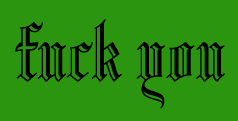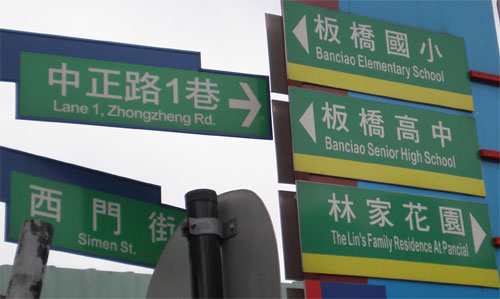This morning all three of Taiwan’s English-language newspapers ran the AP story on the Ministry of the Interior’s plan to expand the use of Tongyong Pinyin. (Bonus points to the copy editor at the Taipei Times who changed the original article’s sloppy “Taiwan will standardize the English transliterations of its Chinese Mandarin place names by the end of the year” to “The Romanization of Mandarin place names will be standardized by the end of this year.”)
I have made a few calls about this, but to little effect so far. Unfortunately, I haven’t had the time today to track down someone at the Ministry of the Interior who can give some definitive information about this.
Meanwhile, here’s another article. It gives a little more information: no intercapping (good), hyphens instead of apostrophes (bad), some screwed-up word parsing (bad).
But all of this sounds like old news. How this will be any different in implementation is still unclear.
Wàijí rénshì lái Táiwān gōngzuò huò lǚyóu, zǒng bèi Táiwān de dìmíng yì xiě gǎo de “wù shàsha,” jiéjú cháng yǐ mílù shōuchǎng. Nèizhèngbù 30 rì gōng bù “biāozhǔn dìmíng yì xiě zhǔnzé” cǎo’àn, míng dìng dìmíng yì xiě yǐ “yīnyì” wèi yuánzé, bìng cǎi “Tōngyòng Pīnyīn” wèi jīzhǔn, ruò dìmíng yǒu lìshǐ, yǔyán, guójì guànyòng, shùzì děng tèxìng, zé yǐ dìmíng xìngzhì fānyì, rú Rìyuè Tán yì wéi “Sun Moon Lake;” 306 gāodì yì wéi “Highland 306.”
Gāi cǎo’àn shì yījù “guótǔ cèhuì fǎ” dìngdìng, bìng nàrù Jiàoyùbù zhìdìng de “Zhōngwén yìyīn shǐyòng yuánzé” zuòwéi yì xiě biāozhǔn, dìmíng yì xiě fāngshì yóu dìmíng zhǔguǎn jīguān zìxíng juédìng.
Cǎo’àn zhǐchū, wèi bìmiǎn yì xiě zhě duì wényì rènzhī bùtóng, chǎnshēng yì xiě chāyì, tǒngyī xíngzhèng qūyù de biāozhǔn yì xiě fāngshì, shěng “Province,” shì “City,” xiàn “County,” xiāng-zhèn “Township,” qū “District,” cūnli “Village.” Jiēdào míngchēng yě tǒngyī yì xiě, dàdào “Boulevard,” lù “Road,” jiē “Street,” xiàng “lane,” nòng “Alley.” Lìrú Kǎidágélán Dàdào wéi “Kaidagelan Boulevard.”
Cǎo’àn míng dìng, biāozhǔn dìmíng de yì xiě cǎi tōngyòng pīnyīn, dàn dìmíng hányǒu “shǔxìng míngchēng” shí, yǐ shǔxìng míngchēng yìyì fāngshì yì xiě, rú Dōng Fēng zhíyì wéi “East Peak.”
Ruò shǔxìng míngchēng yǔ biāozhǔn dìmíng zhěngtǐ shìwéi yī ge zhuānyǒu míngchēng shí, bù lìng yǐ yìyì fāngshì fēnkāi yì xiě, rú “Jiā-Nán dà zùn [zhèn?]” yì wéi “Jianan dazun;” Yángmíng Shān yì wéi “Yangmingshan;” Zhúzi Hú yì wéi “Jhuzihhu.”
Lìngwài dìmíng yǒu dāngdì lìshǐ, yǔyán, fēngsúxíguàn, zōngjiào xìnyǎng, guójì guànyòng huò qítā tèshū yuányīn, jīng zhǔguǎn jīguān bào zhōngyāng zhǔguǎn jīguān hédìng hòu, bù shòu “shǔxìng míngchēng” xiànzhì, rú Yù Shān zhíyì wéi Jade Mountain; zhōngyāng shānmài yì wéi “Central Mountains.”
Cǎo’àn guīdìng, biāozhǔn dìmíng yì xiě shūxiě fāngshì, dì-yī ge zìmǔ dàxiě, qíyú zìmǔ xiǎoxiě, rú bǎnqiáo yì wéi “Banciao,” ér fēi “Ban Ciao” huò “Ban-ciao.” Dàn dìmíng de dì-yī ge zì yǐhòu de pīnyīn zìmǔ, chūxiàn a, o, e shí, yǔ qián dānzì jiān yǐ duǎnxiàn liánjiē, rú Qīlǐ’àn yì wéi “Cili-an,” Rén’ài Xiāng wéi “Ren-ai Township.”
Cǐwài, cǎo’àn yě tǒngyī zìrán dìlǐ shítǐ shǔxìng míngchēng, rú píngyuán, péndì, dǎoyǔ, qúndǎo, liè yǔ, jiāo, tān, shāzhōu, jiǎjiǎo, shān, shānmài, fēng, hé xī, hú, tán děng shíwǔ zhǒng yì xiě fāngshì. Lìrú, Dōngshā Qúndǎo yì wéi “Dongsha Islands;” Diàoyútái liè yǔ “Diaoyutai Archipelago;” Běiwèi Tān “Beiwei Bank;” “Ālǐ Shān shānmài” yì wéi “Alishan Mountains;” zhǔfēng yì wéi “Main Peak;” Shānhútán zhíyì wéi “Shanhu Pond.”
source: Yīngyì yǒu “zhǔn” — lǎowài zhǎo lù bùzài wù shàsha (英譯有「準」 老外找路不再霧煞煞), China Times, October 31, 2007

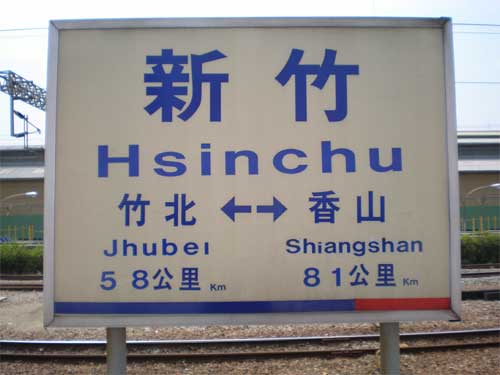
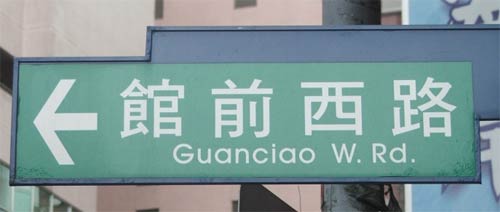
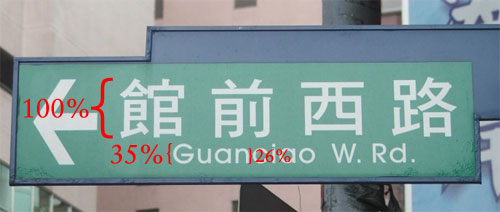
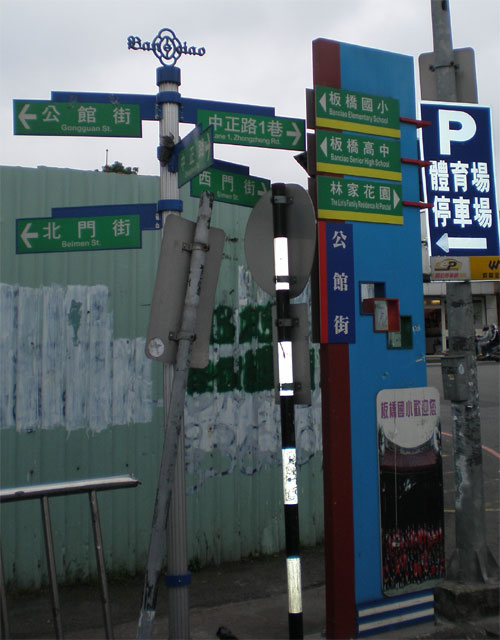
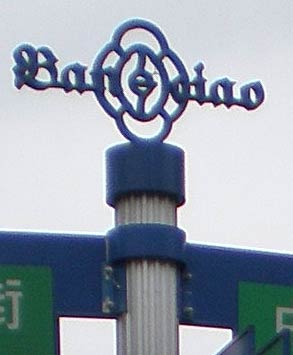 OK, now note the cap on the signpost. It reads “Ban ciao” in
OK, now note the cap on the signpost. It reads “Ban ciao” in 